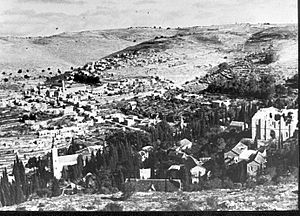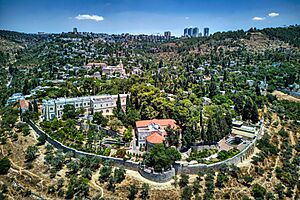Ein Karem facts for kids
Quick facts for kids
Ein Karem
|
|
|---|---|
|
Neighborhood of Jerusalem
|
|

View of Ein Karem
|
|
| Country | |
| District | Jerusalem District |
| City | Jerusalem |
| Founded | Middle Bronze Age |
| Population
(2017)
|
|
| • Total | 1,620 |
Ein Karem (Hebrew: עֵין כֶּרֶם, ʿEin Kerem meaning "Spring of the Vineyard"; in Arabic ʿAyn Kārim) is a very old mountain village. It is located southwest of Jerusalem and is now a neighborhood on the edge of the modern city. Ein Karem is famous for being the place where John the Baptist is believed to have been born. This makes it a very important spot for Christians.
Because of its history and location between Bethlehem and Jerusalem, many churches and monasteries were built here over time. Today, Ein Karem is a lively and artistic neighborhood in Jerusalem. It has kept its old-world charm with preserved houses and beautiful nature. Millions of visitors come each year, including many pilgrims from all over the world. Besides its religious sites, Ein Karem is also known for its art, food, and music.
Contents
What's in a Name?
The name Ein Karem means "Spring of the Vineyard" in both Hebrew and Arabic. This name comes from the natural springs and vineyards that grew on the hillsides of the village.
Some people think the name might also come from an ancient city called Carem. This city was mentioned in the Bible as part of the land of the tribe of Judah. In Arabic, the name can also mean "the Generous Spring."
A Look Back in Time
Ein Karem has been a place where people lived for a very long time, thanks to its natural spring that provides water.
Ancient Times
Pottery found near the spring shows that people lived here as far back as the Middle Bronze Age.
During the Iron Age, Ein Karem is thought to be the biblical village of Beth HaKerem. This village is mentioned in the books of Jeremiah and Nehemiah in the Bible.
In the time of the Second Temple period, a mikveh (a Jewish ritual bath) was found here. This shows that a Jewish community lived in Ein Karem. Other discoveries like graves, parts of a wall, and an olive press also point to this.
Roman and Byzantine Periods
During excavations at the Church of Saint John the Baptist, a marble statue of Aphrodite was found. It is believed to be from the Roman era. Today, you can see this statue at the Rockefeller Museum.
Christian tradition says that John the Baptist was born in a cave under this church. Digs around the church have also found parts of two Byzantine chapels. These chapels had an inscription about Christian "martyrs."
During the Byzantine period, Ein Karem became known as the place of the "Visitation." This is when Mary, who was expecting Jesus, visited her cousin Elizabeth, who was pregnant with John the Baptist.
Early Islamic and Crusader Times
Ein Karem was recorded after the Islamic conquest. An old physician named Al-Tamimi (who died in 990 CE) wrote about a church in Ein Karem that Christians respected.
During the Crusades, the village was called St. Jehan de Bois, meaning "Saint John in the Mountains." The Crusaders were the first to build a church dedicated to St. John here. This church was rebuilt later and is still active today.
Later Periods
After Saladin took Jerusalem in 1187, he gave the village of Ein Karem to Abu Madyan, a famous Sufi teacher. The village's income helped support a special religious fund (called a waqf) for the Moroccan Muslim community in Jerusalem.
A coin from the year 1389 CE was found here, along with pottery and other items from the Mamluk period.
Ottoman Period
Most of the village's land was part of the waqf set up by Abu Madyan. In 1517, Ein Karem became part of the Ottoman Empire. Records from 1596 show that the village had 29 Muslim households. They paid taxes on their crops and animals.
In the 17th century, the Franciscans managed to rebuild the church over the traditional birth cave of St. John. They faced some challenges from local Muslim residents but eventually succeeded.
In the 19th century, Ein Karem was considered the most important village west of Jerusalem. Visitors often described it as a beautiful and pleasant place. In 1863, it was noted that about 250 of the thousand inhabitants were Catholic Christians, and the rest were Muslim.
By 1883, the village had about 600 people, with 100 being Latin Christians. A beautiful spring, called 'Ain Sitti Miriam, was located below the village. By 1896, the population grew to about 1,290 people.
British Mandate Period
In 1922, a census showed that Ein Karem had 1,735 people: 1,282 Muslims and 453 Christians. By 1931, the population had grown to 2,637.
During the 1929 riots, Arab residents from Ein Karem attacked a nearby Jewish neighborhood.
By 1945, Ein Karem had 3,180 people (2,510 Muslims and 670 Christians). Most of its land was used for farming.
The 1947 United Nations Partition Plan for Palestine suggested that Ein Karem should be part of an internationally controlled area around Jerusalem.
1948 War and After
During the 1948 war, Ein Karem became a base for fighters. Many women and children were moved out of the village in April 1948. The village was taken by Israeli forces in July 1948, and the remaining residents left.
After the war, Israel included the village within Jerusalem's city limits. Ein Karem was one of the few Arab villages that survived the war with most of its buildings still standing. The empty homes were then settled by new people, many of them Jewish immigrants from Arab countries. Over time, the peaceful atmosphere attracted many artists and craftspeople. Today, it is a lively and artistic neighborhood.
In 1961, the Hadassah Medical Center was built on a nearby hilltop. It includes the Hadassah Hospital and schools for medicine, dentistry, and nursing from the Hebrew University of Jerusalem.
Biblical Connections
Old Testament
The Septuagint (a Greek translation of the Hebrew Bible) mentions a place called "Carem" in the hills of Judah.
New Testament
The New Testament says that Mary traveled "into the hill country, to a city of Judah" (Luke 1:39) to visit her cousin Elizabeth.
During the Byzantine period, a writer named Theodosius (around 530 CE) said that Elizabeth's town was about 5 miles from Jerusalem, which matches Ein Karem's location.
An old calendar from Jerusalem, possibly from before 638 CE, mentions "Enqarim" as the place for a festival honoring Elizabeth.
Famous Landmarks
Ein Karem is home to several important religious sites and institutions.
Church of the Visitation
This church is located across the village. It is believed to be the summer home of John the Baptist's parents, and where Mary visited them. The modern church was built in 1955 by an Italian architect named Antonio Barluzzi. It stands on top of older church ruins.
Monastery of St. John in the Mountains
This Catholic monastery has a church built over a cave. This cave is traditionally believed to be the birthplace of Saint John the Baptist. The church is built over parts of a Crusader church and two Byzantine chapels with mosaic floors. The church was largely completed in 1939, also designed by Antonio Barluzzi.
Archaeologists found parts of a Jewish ritual bath (mikve) from the Second Temple Period under the church's porch.
The Franciscans bought the ruins of the Crusader church in 1621. After many years, they managed to rebuild and strengthen their church and monastery by the 1690s.
Convent of the Sisters of Zion
This monastery was built in 1860 by two French brothers, Marie-Théodore Ratisbonne and Marie-Alphonse Ratisbonne. They were born Jewish and later became Christian. They started an orphanage here. Alphonse lived in the monastery and is buried in its garden.
Gorny or "Moscobia" Convent
This convent was started by the Russian Orthodox Church in 1871. The name "Gorny Convent" means "mountainous" in Russian, referring to Mary's visit to Elizabeth in the "hill country." Local Arab villagers called it "Muskobiya," which became "Moskovia" in Hebrew. It has three churches inside its walls. The Church of Our Lady of Kazan was built in 1873. The Cathedral of All Russian Saints, with its golden domes, was finished in 2007. There is also a cave church dedicated to St. John the Baptist, consecrated in 1987.
Mary's Spring
A Christian tradition from the 14th century says that the Virgin Mary drank water from this village spring. It is also believed to be where Mary and Elizabeth met. Because of this, the spring is known as the Fountain of the Virgin. Many Catholic and Orthodox Christian pilgrims visit the spring and believe its waters are holy.
What looks like a spring is actually the end of an old water channel. The former Arab residents built a mosque and school here. A shrine and a minaret from the mosque still remain. The mosque was built in 1828–1829 CE.
St. Vincent
St. Vincent-Ein Kerem is a special home for children with physical or mental disabilities. It was founded in 1954 and is run by the Daughters of Charity of St. Vincent de Paul.
Other Religious Places
Catholic
- The Convent of the Franciscan Sisters
- The Convent of the Rosary Sisters, built in 1910
- Casa Nova, a guesthouse for pilgrims that reopened in 2014
Greek Orthodox
- The Greek Orthodox Church of St John, built in 1894 on the remains of an ancient church.
Nearby Sites
Monastery of St. John in the Wilderness
This monastery has a cave linked to Saint John the Baptist. It is located near Ein Karem and the village of Even Sapir.
People from Ein Karem
- Shlomo Aronson (1936–2018), a famous Israeli landscape architect.
- Erel Margalit (born 1961), an Israeli entrepreneur in technology and social projects.
- Naomi Henrik (1920–2018), an Israeli sculptor.
See also
 In Spanish: Ein Karem para niños
In Spanish: Ein Karem para niños













